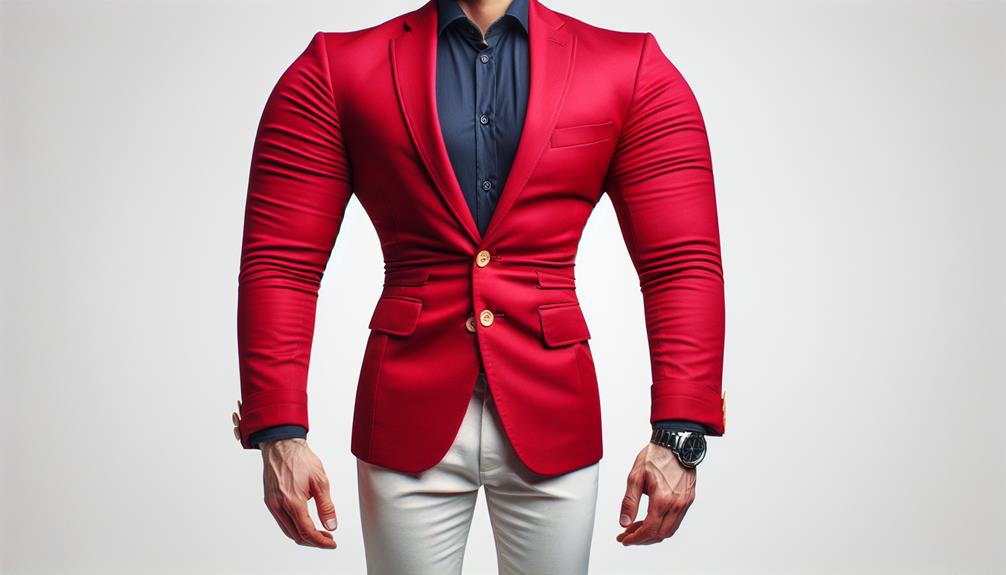When it comes to men's blazer sizing, understanding the different size terminology can play a significant role in finding the perfect fit. Ensuring that the blazer fits just right involves more than just picking a standard small, medium, or large size.
By considering key measurements like chest, waist, and length, you can navigate the world of blazer sizing with confidence. Stay tuned to discover how these measurements can make all the difference in achieving a polished and tailored look effortlessly.
Table of Contents
Key Takeaways
- Understanding blazer size terminology simplifies selecting the right jacket length.
- Key measurements like chest and waistband ensure a tailored and comfortable fit.
- Different styles like slim-fit and single-breasted offer versatility in wardrobe choices.
- Tailoring adjustments like waist size and sleeve length enhance the blazer's fit and polished appearance.
Understanding Blazer Size Terminology
Blazer size terminology, such as S, R, L, and XL, simplifies the process of selecting the right jacket length option. Understanding these sizes is important for achieving a polished look. When it comes to suit jacket size, the chest measurement is a key factor. For short (S) sizes, designed for individuals 5'8' and under, the jacket length is shorter to complement the wearer's height. On the other hand, extra-long (XL) sizes cater to those 6'5' and taller, providing the necessary length for a proportional appearance.
Knowing the right blazer size ensures a proper fit that enhances your overall style. It's important to take your height and chest measurement into account to determine the most suitable size. Short sizes offer a solution for shorter individuals, while extra-long sizes cater to taller men, ensuring that the jacket length complements their stature. Mastering blazer size terminology allows for a sophisticated and tailored look that exudes confidence.
Key Measurements for Blazer Sizing
When determining the ideal blazer size, precision in measuring the fullest part of the chest is paramount. Matching the chest size to the jacket size guarantees a well-fitted blazer. Additionally, selecting the appropriate jacket length using size options like S, R, L, or XL is vital for achieving the right fit. For those 5'8' and shorter, short sizes are recommended, whereas extra-long sizes are ideal for individuals 6'5' and taller. When it comes to pant sizing, accurately measuring the waistband of well-fitting dress pants or the actual waist is key in determining the correct pant size.
| Measurement | Importance |
|---|---|
| Chest Size | Essential for matching with the correct jacket size to achieve a well-fitted blazer. |
| Jacket Length | Choosing the right length using size options like S, R, L, or XL is important for a proper fit. |
| Pant Size | Accurately measuring the waistband or actual waist helps determine the correct pant size for a good fit. |
| Size Options | Selecting the appropriate size options guarantees a tailored look and comfortable wear. |
Different Styles of Men's Blazers
Exploring the diverse range of men's blazer styles reveals a spectrum of options from slim-fit to classic-fit, each tailored to different preferences. When considering the size of a blazer, it's important to pay attention to the chest measurement to make sure of a proper fit. Slim-fit blazers offer a more tapered look, hugging the body closely, while classic-fit blazers provide a more relaxed and traditional silhouette.
Regarding pants, men's blazers are often paired with matching trousers to create a cohesive ensemble. The sleeve length of a blazer plays a significant role in achieving a polished appearance. It's essential to have the sleeves tailored to the correct length, typically ending at the base of the thumb.
Different styles of men's blazers cater to various occasions and personal styles. Whether opting for a single-breasted blazer for a versatile look or a double-breasted blazer for a formal touch, understanding the nuances of each style can elevate your wardrobe.
Tips for Achieving the Perfect Fit
When aiming for the perfect fit in a men's blazer, focus on how it complements your body shape and consider any needed adjustments to sleeve length.
Taking these steps guarantees that the blazer looks tailored and polished, enhancing your overall appearance effortlessly.
It's all about achieving a sharp and comfortable fit that exudes confidence and style.
Fit for Body Shape
Taking your body shape into account is crucial when choosing a blazer to make sure it enhances your overall appearance.
- Tailored Fits: Opt for tailored blazers for a sleek silhouette that complements slim body types.
- Structured Blazers: Athletic builds benefit from structured blazers to emphasize shoulders and chest, creating a more balanced look.
- Classic Fits: Broader body shapes find comfort and ease in classic fit blazers, offering a timeless and flattering style.
When selecting a blazer, refer to the size chart to make sure it will fit you well, especially around the fullest part of your body. Understanding your body proportions is key to choosing the most flattering blazer style for your specific physique.
Sleeve Length Adjustment
To make sure your blazer fits impeccably, mastering the adjustment of sleeve length is imperative for a polished and comfortable look.
The sleeve length of a blazer should ideally end at the base of the thumb bone, ensuring both style and ease of movement.
Tailors possess the expertise to adjust sleeve lengths by repositioning buttons, altering cuffs, or modifying the fabric at the shoulder, achieving a precise fit.
Properly tailored sleeves not only enhance the overall appearance of a blazer but also allow for natural movements without constraint.
Common Fit Issues and Solutions
I've encountered common fit issues with my men's blazers, like tightness in the chest and shoulders, restricted arm movement, and excess fabric around the waist. To resolve these problems, I've found that opting for a larger size or a slim-fit design can help with chest and shoulder tightness.
Choosing stretch fabric or a tailored option improves arm movement. Excess waist fabric can be tackled by getting the blazer tailored to cinch the waist or choosing a slimmer-cut style, ensuring a comfortable and stylish look.
Sleeve Length Adjustment
When adjusting the sleeve length of a blazer, seeking a professional tailor's expertise guarantees a precise fit that enhances both comfort and style. Improper sleeve length can throw off the proportions of the blazer, impacting the overall look of the outfit.
Here are three key points to bear in mind when adjusting sleeve length:
- Tailor Precision: A skilled tailor makes sure the sleeves are the correct length, aligning perfectly with your wrist bone for a polished appearance.
- Comfort Enhancement: Proper sleeve length not only improves the aesthetics but also enhances comfort by allowing natural movement without restriction.
- Style Elevation: Well-fitted sleeves elevate the overall style quotient of the blazer, giving a more tailored and sophisticated look.
Shoulder Width Correction
Adjusting the shoulder width of a blazer is crucial for ensuring both comfort and a polished appearance, addressing common fit issues that can impact the overall look and feel of the garment. Proper fit is essential to prevent any discomfort or restricted movement caused by shoulder width discrepancies. Tailors possess the expertise to correct this by repositioning the seam, ensuring the blazer aligns with the natural shoulder for an impeccable fit. This adjustment not only enhances mobility but also prevents any pulling or tightness in the chest and back. By focusing on shoulder width correction, the blazer achieves a balanced silhouette, elevating the overall aesthetic appeal and ensuring a refined look.
| Shoulder Width Correction | Importance |
|---|---|
| Aligning seam with natural shoulder | Ensures comfort and mobility |
| Tailors repositioning seam | Maintains jacket structure |
| Prevents pulling or tightness | Enhances fit |
| Balanced silhouette | Polished appearance |
Tailoring Your Blazer for a Custom Fit
Customizing my blazer guarantees a personalized fit that complements my body shape and size. When tailoring your blazer, focus on key areas to achieve the perfect fit:
- Adjusting Waist Size: Tailoring the waist of your blazer can create a more flattering silhouette by making sure it follows your body's natural contours.
- Optimizing Sleeve Length: Tailoring the sleeve length is important to make sure the cuffs hit at the right point on your wrist, enhancing both comfort and style.
- Properly Tailored Fit: Letting out or taking in the sides of the blazer can help achieve a snug yet comfortable fit. A properly tailored blazer not only enhances your overall look but also boosts your confidence when wearing it.
Blazer Sizing Chart and Conversion Guide
Exploring a blazer sizing chart can simplify the process of finding the perfect fit for your body type and preferences. Blazers typically range from size 34 to 52, correlating with chest measurements. It's important to consult size charts as different brands may have varying sizing standards.
For a better fit, off-the-rack blazers often offer Short (S), Regular (R), and Long (L) sizes. The letter sizing in blazers denotes sleeve length, impacting the overall jacket fit. To make sure you choose the correct size, measure around your chest at the widest point and consult the size chart provided by the brand.
Taking accurate measurements using a tape measure is essential for achieving a comfortable and well-fitted blazer. By understanding the size charts and utilizing the conversion guide, you can confidently select a blazer that complements your physique and style preferences.
Frequently Asked Questions
How Do I Know My Blazer Size?
To know my blazer size, I measure the fullest part of my chest accurately, match it to the corresponding jacket size, and consider Short (S), Regular (R), Long (L), or Extra Long (XL) options based on my height.
What Size Is 42 in Mens Blazer?
Size 42 in men's blazers typically fits a chest measurement of around 42 inches. It falls within the standard size range, offering a balanced fit for most individuals. Understanding the correlation between chest size and blazer size is essential.
What Does 42r Mean in Suit Size?
Understanding suit sizes is essential. The '42R' label signifies a 42-inch chest with a Regular jacket length, ideal for average height. The chest measurement is key. This knowledge helps me choose the right fit for a suit jacket.
What Size Is 32 in Blazer?
Size 32 in a blazer typically corresponds to a chest measurement of around 32 inches. It's important to refer to the brand's size chart for accuracy since sizes can vary. Understanding this relationship helps guarantee a proper fit.
- Tetron Fabric for Marine Applications: Durability and Use Cases - June 18, 2025
- Tetron Fabric for Outdoor Furniture: Weather Resistance and Care - June 18, 2025
- Tetron Fabric for Wall Coverings: Style and Application Tips - June 18, 2025





